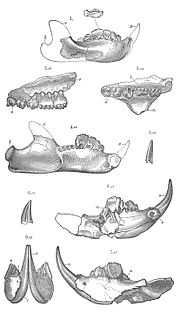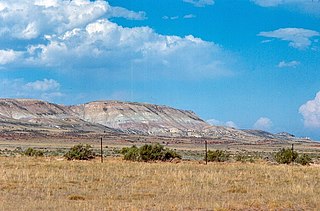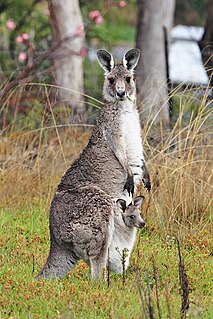
Ctenacodon is a genus of extinct mammal that lived in what is now North America during the Upper Jurassic period. It is a member of the family Allodontidae within the order Multituberculata. Ctenacodon, also known as Allodon, was named by Othniel Charles Marsh in 1879. At least three species are currently recognized.
Psalodon is an extinct genus of North American mammal that lived during the Upper Jurassic period. It's a member of the family Allodontidae within the order Multituberculata.
Zofiabaatar is a genus of extinct mammal from the Upper Jurassic period. It was a relatively early member of the extinct order Multituberculata within the suborder "Plagiaulacida". It lived in North America along with dinosaurs such as Diplodocus and Allosaurus.
Bolodon is a genus of extinct mammal from the Lower Cretaceous of Europe and North America. It was a member of the extinct order of Multituberculata and belongs to the suborder Plagiaulacida and family Plagiaulacidae.
Ameribaatar is an extinct mammal of the Late Cretaceous. It was a member of the also extinct order of Multituberculata. It lived in North America during the Mesozoic, also known as the "age of the dinosaurs". Whether it belongs to Plagiaulacida, Cimolodonta, or neither, is unclear. The genus Ameribaatar was named by Eaton and Cifelli in 2001.

Como Bluff is a long ridge extending east-west, located between the towns of Rock River and Medicine Bow, Wyoming. The ridge is an anticline, formed as a result of compressional geological folding. Three geological formations, the Sundance, the Morrison, and the Cloverly Formations, containing fossil remains from the Late Jurassic of the Mesozoic Era are exposed. Nineteenth century paleontologists discovered many well-preserved specimens of dinosaurs, as well as mammals, turtles, crocodilians, and fish from the Morrison Formation. Because of this, Como Bluff is considered to be one of the major sites for the early discovery of dinosaur remains. Among the species discovered is the only known specimen of Coelurus. Significant discoveries were made in 22 different areas scattered along the entire length of the ridge. It is included on the National Register of Historic Places as well as the National Natural Landmark list.

Sinoconodon is an extinct genus of mammaliamorphs that appears in the fossil record of the Lufeng Formation of China in the Sinemurian stage of the Early Jurassic period, about 193 million years ago. While sharing many plesiomorphic traits with other non-mammaliaform cynodonts, it possessed a special, secondarily evolved jaw joint between the dentary and the squamosal bones, which in more derived taxa would replace the primitive tetrapod one between the articular and quadrate bones. The presence of a dentary-squamosal joint is a trait historically used to define mammals.

Gobiconodon is an extinct genus of carnivorous mammal from the Middle Jurassic to Early Cretaceous. It weighed 10–12 pounds (4.5–5.4 kg) and measured 18–20 inches (460–510 mm). It was one of the largest mammals known from the Mesozoic. Like other gobiconodontids, it possesses several speciations towards carnivory, such as shearing molar teeth, large canine-like incisors and powerful jaw and forelimb musculature, indicating that it probably fed on vertebrate prey; rather uniquely among predatory mammals and other eutriconodonts, the lower canines were vestigial, with the first lower incisor pair having become massive and canine-like. Like the larger Repenomamus there might be some evidence of scavenging.

Trechnotheria is a group of mammals that includes the therians and some fossil mammals from the Mesozoic Era. In the Jurassic through Cretaceous periods, the group was endemic to what would be Asia and Africa.

Amphitheriidae is a family of Mesozoic mammals restricted to the Middle Jurassic of Britain, with indeterminate members also possibly known from the equivalently aged Itat Formation in Siberia and the Anoual Formation of Morocco. They were members of Cladotheria, more derived than members of Dryolestida, and forming a close relationship with Peramuridae. Amphitheriidae is the only family of the order Amphitheriida.
Shuotherium is a fossil mammal known from Middle-Late Jurassic of the Forest Marble Formation of England, and the Shaximiao Formation of Sichuan, China.

The Morrison Formation is a distinctive sequence of Late Jurassic sedimentary rock that is found in the western United States, which has a wide assortment of taxa represented in its fossil record, including dinosaur fossils in North America. It is composed of mudstone, sandstone, siltstone and limestone and is light grey, greenish gray, or red. Most of the fossils occur in the green siltstone beds and lower sandstones, relics of the rivers and floodplains of the Jurassic period.
Enneabatrachus is an extinct genus of prehistoric frogs known from the late Jurassic Morrison Formation. It is represented by a single species, Enneabatrachus hechti, whose remains have been recovered from stratigraphic zone 5. One specimen has been recovered from Quarry 9 of Como Bluff in Wyoming and another specimen was later reported from Dinosaur National Monument. A small discoglossid frog whose name means "nine frog" after the quarry in which it was discovered. The Como Bluff specimen was an ilium only a few millimeters long. E. hechti's live weight would have only been a few grams.
Amphidon is an extinct genus of Late Jurassic mammal from the Morrison Formation. It is present in stratigraphic zone 5. The only species in the genus is Amphidon aequicrurius, found by Simpson in 1925.
Trioracodon is an extinct genus of Late Jurassic to Early Cretaceous eutriconodont mammal found in North America and the British Isles. It was named in 1928

Paurodon is an extinct genus of Late Jurassic mammal from the Morrison Formation of the Western United States.
Euthlastus is an extinct genus of Late Jurassic mammal from the Morrison Formation. Present in stratigraphic zones 5 and 6. It is represented by only five upper molars.
Eobatrachus is a dubious genus of extinct frog known only from the holotype, YPM 1862, part of the right humerus, found in Reed's Quarry 9 near Como Bluff, Wyoming in the Late Jurassic-aged Morrison Formation. The type, and only species, E. agilis, was named by Othniel Charles Marsh in 1887 and he initially interpreted it as a mammal, although it was later re-classified as a genus of frog related to Comobatrachus and Eobatrachus is now seen as a dubious amphibian genus, possibly belonging to Anura (frogs) according to Foster (2007).
The Amphidontidae are a family of extinct mammals from the Early Cretaceous, belonging to the triconodonts. It contains most of the species previously belonged to Amphilestidae.













